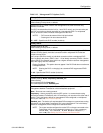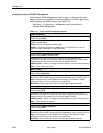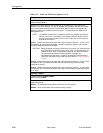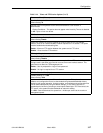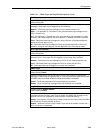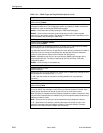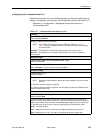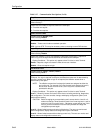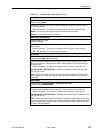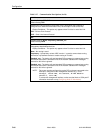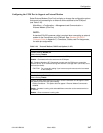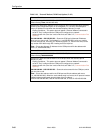
Configuration
3-61
9124-A2-LB20-00
March 2000
Table 3-16. SNMP Traps and Trap Dial-Out Options (3 of 4)
Link Traps Interfaces
Possible Settings: Network, DSX-1, T1s, Ports, All
Default Setting: All
Specifies which interfaces will generate linkUp, linkDown, and enterpriseSpecific trap
messages. These traps are not supported on the COM port.
Network – Generates these trap messages on the network interface only.
DSX-1 – For applicable T1 FrameSaver units, generates these trap messages on the
DSX-1 interface only.
T1s – For applicable T1 FrameSaver units, generates these trap messages for linkUp,
linkDown, and enterpriseSpecific events on both the T1 network and DSX-1 interfaces.
Ports – Generates these trap messages for linkUp, linkDown, and enterpriseSpecific
events on the user data port only.
All – Generates these trap messages for linkUp and enterpriseSpecific events on all
interfaces, except for the COM port, that are applicable to the FrameSaver model.
DLCI Traps on Interfaces
Possible Settings: Network, Ports, All
Default Setting: All
Specifies which interfaces will generate linkUp and linkDown trap messages for
individual DLCIs. These traps are only supported on the frame relay interfaces.
Network – Generates these trap messages on DLCIs for the network interface only.
Ports – Generates these trap messages for DLCIs on a user data port only.
All – Generates these trap messages on all frame relay interfaces.
RMON Traps
Possible Settings: Enable, Disable
Default Setting: Enable
Specifies whether remote monitoring traps are sent to the currently configured trap
manager(s). RMON traps are typically sent as a result of the Alarms and Events Groups
of RMON1 when a selected variable’s configured threshold is exceeded.
Enable – Sends trap messages when set thresholds are exceeded.
Disable – Does not send trap messages when set thresholds are exceeded.
Trap Dial-Out
Possible Settings: Enable, Disable
Default Setting: Disable
Controls whether SNMP trap messages initiate a call automatically. If the call cannot be
completed and the Call Retry option is set to Enable, the SNMP trap message is held
(queued) until the call completes to either the Alarm or alternate directory.
Enable – Automatically calls the phone number contained in the Control menu’s Modem
Call Directories, Directory Number A (Alarm).
Disable – Automatic calls will not be initiated. Traps sent to the modem are held until a
dial-in connection is established.



